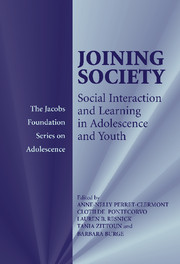Book contents
- Frontmatter
- Contents
- List of Contributors
- Foreword
- Preface
- I Introduction
- II Youth-Constructed Socialization
- 4 Risks, Rules, and Roles: Youth Perspectives on the Work of Learning for Community Development
- 5 Youth Between Integration and Disaffiliation in French Cities
- 6 A New Identity, A New Lifestyle
- 7 Becoming a Member by Following the Rules
- III Personal Agency Through Collective Activity
- IV Learning in Practice and Discourse
- V Intergenerational Sites for Thinking
- VI Pathways to Adulthood in National Context
- Index
- References
7 - Becoming a Member by Following the Rules
Published online by Cambridge University Press: 08 January 2010
- Frontmatter
- Contents
- List of Contributors
- Foreword
- Preface
- I Introduction
- II Youth-Constructed Socialization
- 4 Risks, Rules, and Roles: Youth Perspectives on the Work of Learning for Community Development
- 5 Youth Between Integration and Disaffiliation in French Cities
- 6 A New Identity, A New Lifestyle
- 7 Becoming a Member by Following the Rules
- III Personal Agency Through Collective Activity
- IV Learning in Practice and Discourse
- V Intergenerational Sites for Thinking
- VI Pathways to Adulthood in National Context
- Index
- References
Summary
Karsten Hundeide's chapter (this volume) raises the questions of why and by which mechanisms – particularly psychological – some marginalized, delinquent young people are converted to sectarian, violent, or extremist groups that are much more demanding than is society in general. What can we learn from these ways of life, these alternative lifestyles? How can we think of rehabilitating the young people involved in a manner that could be congruent with their new identities?
For me, a sociologist of education and an ethnomethodologist, these questions raised two issues:
What does it mean to be a member of a social group?
What is involved in following a rule?
What Is Becoming a Member?
In the language of ethnomethodology, being a member is a technical term meaning sharing the language of the group in question. It means sharing a common world, common perspectives, and ways of categorizing reality. It conveys the impression of living in a unified and uniform culture when its members are at ease in the following senses: They have naturalized and incorporated the innumerable details of daily life, including minute details of behavior, clothing, and talk that allow the members to recognize each other instantly. This community of schemes of thought and action, which Pierre Bourdieu (1987) calls habitus, generates nonreflective actions and always shapes agents' practices, but it can be discussed.
- Type
- Chapter
- Information
- Joining SocietySocial Interaction and Learning in Adolescence and Youth, pp. 109 - 116Publisher: Cambridge University PressPrint publication year: 2003
References
- 1
- Cited by

